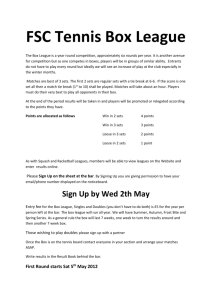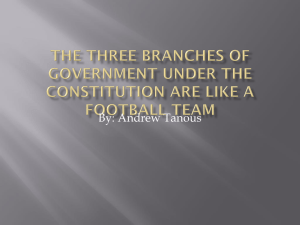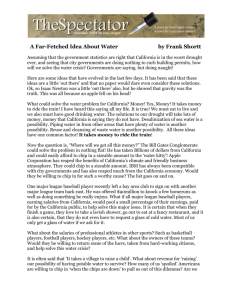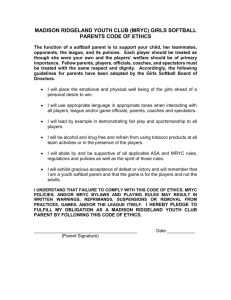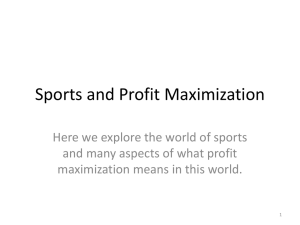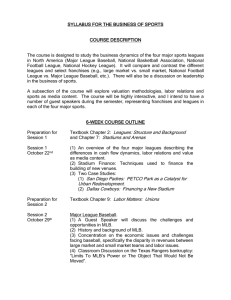Principles & Practice of Sport Management
advertisement
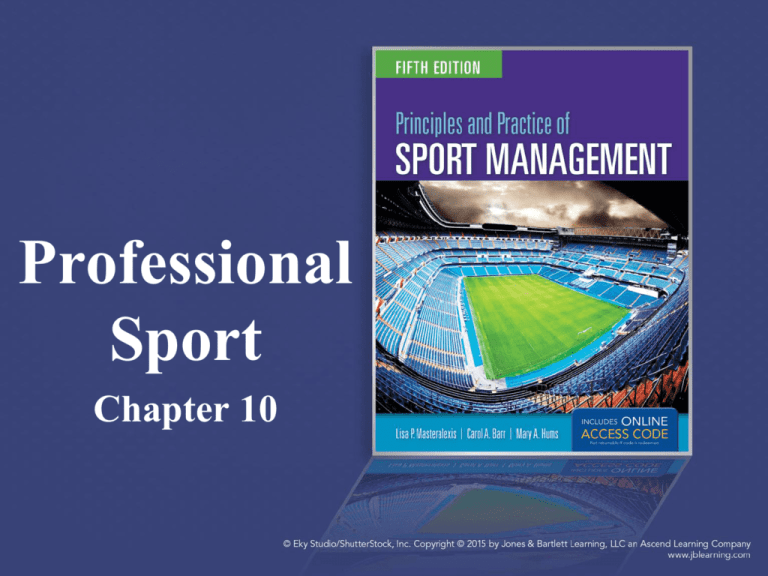
Professional Sport Chapter 10 Introduction • Professional sports are events and exhibitions where athletes compete individually or on teams and perform for pay. • Major international business gross billions of dollars each year through media rights, gate receipts, luxury seating, sponsorship, and properties. • Drafting more international players, the sale of licensed merchandise, and providing online services has catapulted professional sports leagues into new markets. Introduction (cont.) • Five major North American men’s leagues: MLB, NFL, NHL, NBA, and MLS – 141 teams at the major league level • New leagues formed each year; some survive – WNBA, WPS, NLL, etc. • North American minor league teams in baseball, basketball, hockey, arena football, women’s football, tennis, soccer, indoor and outdoor lacrosse too numerous to list Introduction (cont.) • Numerous professional leagues also operate throughout South America, Europe, the Middle East, Asia, Australia, and Africa. • Athletes in professional leagues are salaried employees whose bargaining power and ability to negotiate salaries vary (MLB vs MiLB). • Professional sports events are also staged around the world in individual sports, including tours and exhibitions. Media companies often create events for their athletes and clients. History • 1869: First professional team, the Cincinnati Red Stockings • 1876: North America’s first professional sport league, the National League, emerged – Included bylaws for limits on franchise movement, club territorial rights, and mechanism for expulsion of a club • Self Governance vs corporate governance models: – Owners act as the board of directors, and the commissioner acts as the chief executive officer League Structure • Leagues are structured as an umbrella organization for franchises to cooperate in business while competing on playing field. – League also handles rule making and rule enforcement. • Trend for emerging leagues to be established as single entities to avoid antitrust liability and to create centralized fiscal control (e.g., MLS, WNBA). – MLS challenged in court – WNBA moved to standard league structure Franchise Ownership • Initially sport team ownership was a hobby for the wealthy. – Teams operated as “Mom and Pop” businesses. • Focus of owners today is on running team like a business rather than a hobby. • Most ownership groups today are diversified because of the costs of purchasing and operating a team. – Exception is the NFL: • Family or individual ownership is still the norm because of enhanced degree of revenue sharing. Franchise Ownership Issues • Owners trying to recoup initial investment in club and make more money on their franchises – A growing trend is for owners to challenge league control over shared revenue streams. • Some owners clamoring for local control over marketing revenues using logos, trademarks, and sponsorships – Examples: Dallas Cowboys and NY Yankees • Or working to maximize revenues – Examples: Boston Red Sox and Fenway Sports Group Ownership Rules • Permission to own sports franchise granted by ownership committee of league • League imposes restrictions on ownership, including limit on number of franchise rights granted (number of teams) and restrictions on franchise location • Leagues may also impose eligibility restrictions for franchise ownership. – NFL bans corporate and public ownership. • Franchise and territorial rights are granted with ownership. • Issue of cross-ownership The Commissioner • 1920: First commissioner of a pro sport league – MLB’s Judge Kennesaw Mountain Landis • League constitution and bylaws set forth commissioner’s powers – Granted authority to investigate and impose penalties when individuals are suspected of acting against the best interests of the game • Players’ associations have used collective bargaining to limit commissioner’s powers. – Owners have also challenged commissioner in court, but rulings usually upheld The “Powers” of the Commissioner • • • • Approval of player contracts Resolution of disputes between players and clubs Resolution of disputes between clubs Resolution of disputes between player or club and the league • Disciplinary matters involving owners, clubs, players, and other personnel • Rule-making authority (Yasser et al., 2003, p. 381) Labor Relations • 1885: John Montgomery Ward (a lawyer and HOF infielder/pitcher) established first players’ association to: – Fight reserve system, salary caps, and practice of selling players without the players’ receiving a share of profits – Negotiate wages-benefits-rights with owners • When his plan did not work, about 200 players organized a revolt that led to the organization of the Players League; folded after first year Labor Relations (cont.) • 1952: MLBPA formed – Dominated by management – Negotiations limited to pensions and insurance • 1966: Marvin Miller organized players as true labor union by convincing all players that each of them was essential to game revenues. – Convinced players to fund players’ association by giving their group licensing rights to the union from which the union would operate and give remaining funds back to players in pro-rata shares Labor Relations (cont.) • 1957: NHL players tried to unionize. – NHL owners humiliated, threatened, traded, and/or released players for involvement in players organizing efforts. • Labor relations did not play major role in professional sports until the late 1960s, when growing fan interest and increased TV and sponsorship revenues transformed leagues. • Once players unionize, collective bargaining must occur before league management can change hours, wages, or terms and conditions of employment. Labor Relations (cont.) • With a players union in place, a league can negotiate acceptance for restrictive practices with players’ association. – Practices that on their own might violate antitrust laws • When the collective bargaining process reaches an impasse (a breakdown in negotiations), the players can go on strike or owners can “lock out” players. • Strikes and lockouts are far more disruptive in professional sports than in other industries because of the lack of replacement players (employees). • Leagues encourage unions because labor exemptions can be used to implement restrictive policies. Individual Professional Sports: PGA as Case Study • 1916: Birth of PGA – Objectives are to grow golf interest, elevate standards of golf professionals, establish a relief fund, and hold meetings and tournaments • 1960s: Many factors created growing tension between the PGA tournament professionals and the local country club professionals, and conflicts arose. – 1968: PGA tournament players broke away from the larger membership to form a Tournament Players Division (1975: renamed PGA Tour) Individual Professional Sports: PGA as Case Study (cont.) • Tours in the individual sports have their own qualification rules and regulations. • For six decades, players had to qualify annually for the PGA Tour through a grueling qualifying tournament known as Q-School, unless they earned an exemption by winning a tournament or one of the four majors. • Current players must qualify annually for the PGA Tour based on their prior year’s performance on the Tour or by moving up through the ranks on the Web.com Tour. Key Concepts: League Revenues • League revenues derive from: – National TV and radio contracts – League wide licensing – League wide sponsorship programs • Local revenues kept by local teams: – Local broadcasting-media contracts – Gate receipts – Preferred seating sales – Other forms of stadium revenues – Creates competitive balance Key Concepts: Franchise Values and Revenue Generation • Owners diversify investments to protect against risk that a franchise will lose a great deal of money. • Currently, franchise values for major league clubs are in the hundreds of millions of dollars, with the most lucrative reaching into the billions. • Franchise free agency—’stadium games’: – Team owners threaten to move teams if their demands for new stadiums, renovations to existing stadiums, or better lease agreements are not met. Key Concepts: Franchise Values and Revenue Generation (cont.) • Example of revenue generation: Boston Red Sox, who are maximizing revenue potential in every inch of Fenway Park (plus Fenway Sports Group) • Large vs. small-market dichotomy created by the disparity in local broadcast revenues in MLB – Forcing some teams (Oakland A’s) to focus on efficiency and use a system that uses less common statistics, wise drafting, and drafting of players who are “signable” • Labor stability = Cost stability (NFL is example) – Challenge: Long-term CBA creates stability Key Concepts: Legal Issues Contract Law • All players sign a standard player contract particular to each league. • Commissioner of league can refuse to approve player’s contract if he or she believes it violates league rule or policy. • Disputes may occur over which team retains rights to a particular player, and such disputes may lead to legal battles between teams and players of different countries. Key Concepts: Legal Issues Antitrust Law • All professional sport leagues adopt restrictive practices (drafts, reserve systems, salary caps, free agent restrictions, and free agent compensation) to provide financial stability and competitive balance between their teams. – Restrictive practices may depress salaries or keep competitor leagues from signing marquee players. • Such practices are often challenged under antitrust law as anticompetitive. – Argument is that such practices restrain trade or monopolize the market for professional team sports. Key Concepts: Race and Gender in Professional Sports • Shropshire (1996) stresses pointedly that integration of more diverse employees into management positions will not happen without a concerted effort by owners, commissioners, and those in positions of power. • Representation of minorities in sport management should match representation on the field. • All leagues have shown improvements in terms of hiring women and people of color. Key Concepts: Race and Gender in Professional Sports (cont.) • 2003: NBA, NHL, and MLB had improvements in the race categories. – NBA: First African American majority owner was Bob Johnson (Charlotte Bobcats) – MLB: First minority owner was Mexican American Arte Moreno (Anaheim Angels) • Change needs to come from those in position of power and through new policies. • Case Study: NFL’s Rooney Rule Key Concepts: Race and Gender in Professional Sports (cont.) Key Concepts: Race and Gender in Professional Sports (cont.) Career Opportunities: League Office • Commissioner: Wide variety of skills and experience needed to be successful in this high profile management position • Other League Office Personnel: – Hundreds of employees in a range of functional areas – Necessary skills: Vary with position, yet a few universal skills include working knowledge of given sport, teams, and industry; good customer relation skills; willingness to work long hours Career Opportunities: League Office (cont.) Career Opportunities: League Office (cont.) Career Opportunities: League Office (cont.) Career Opportunities: Team Front Office • General Manager: – In charge of all player personnel decisions – Traditionally former player or coach, but as position has become more complex, individuals with graduate degrees have become desirable • Other Team Front Office Personnel: – Number of positions and specialization of jobs has increased greatly. – Entry level tends to be in sales, marketing, community relations, and media/public relations with low starting salaries. Career Opportunities: Tour Personnel • As with league sports, positions range from commissioner to marketer to special events coordinator. – Tours such as PGA and ATP employ many sport managers. • Much of event management work for site operations of tour events; however, it is often left to outside sport agency. Career Opportunities: Agents • Almost all team and individual athletes in professional sports have agents representing them and coordinating business and financial affairs. • A growing number of coaches rely on sports agents. • A range of opportunities is available in sport agencies in marketing, management, finance, accounting, operations, and so on. (See Chapter 11.) Current Issues: Salary Caps • Intended to create parity among teams by capping how much a team can spend on its players’ salaries • Used in the AFL, NBA, NFL, NHL, MLS, WNBA, ECHL, and NLL • Owners must negotiate with the players to have a salary cap, and the union will inevitably negotiate for some exceptions to the salary cap. – Exceptions have created loopholes for creative general managers and agents representing players (exceptions for signing bonuses, veterans, etc.). Current Issues: Salary Caps (cont.) • Caps force teams to cut established players or renegotiate their contracts to make room under the cap to sign another player. • Caps can also require teams to have spending minimums, so low-revenue teams are prevented from cutting their payrolls to stay competitive. Current Issues: Globalization • All major leagues are drafting and signing players from other nations and moving into those countries with marketing efforts. • MLB has an office in Tokyo to oversee its efforts in Japan, Taiwan, and China, plus the league has been playing one game to open the season in Japan for the past few years. • The NFL no longer operates NFL Europe, but has begun playing a marquee regular season game in Europe. • The NBA has expanded throughout the globe with probably the most international movement of all the North American leagues (e.g., NBA China and NBA India). Current Issues: Concussion Litigation • Retired NFL and the NHL players have filed suit against the leagues. • The retired players and their families allege that they have developed chronic traumatic encephalopathy (CTE) and other brain diseases, such as Alzheimer’s, due to head trauma they received while playing professional football and ice hockey. • The NFL has proposed a settlement with the 4,500 plaintiffs in the amount of $765 million, but the judge has denied the initial proposal, as it might not be sufficient to cover medical costs of plaintiffs. Current Issues: Drug Testing and HGH • Human growth hormone (HGH) testing in professional sport has become a significant issue. • The four major leagues have adopted drug testing policies and have adopted the penalties noted in Table 10-5. • The question will be how the leagues manage HGH, which has still to be addressed. • Case Study: MLB and Alex Rodriguez Summary • The professional sport industry involves the sale of the entertainment value of sport events and exhibitions. • Revenue is generated primarily through media rights fees, licensed product sales, gate receipts, and stadium revenues. • The professional sport industry is entering an exciting period. Innovations in technology are making professional sport more global, particularly as leagues look for unsaturated markets and new revenue streams.
